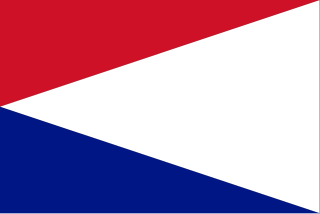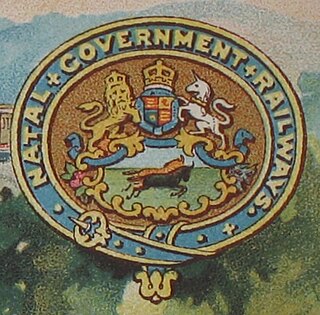
The Orange Free State was an independent Boer sovereign republic under British suzerainty in Southern Africa during the second half of the 19th century, which ceased to exist after it was defeated and surrendered to the British Empire at the end of the Second Boer War in 1902. It is one of the three historical precursors to the present-day Free State province.

The Great Trek was a northward migration of Dutch-speaking settlers who travelled by wagon trains from the Cape Colony into the interior of modern South Africa from 1836 onwards, seeking to live beyond the Cape's British colonial administration. The Great Trek resulted from the culmination of tensions between rural descendants of the Cape's original European settlers, known collectively as Boers, and the British Empire. It was also reflective of an increasingly common trend among individual Boer communities to pursue an isolationist and semi-nomadic lifestyle away from the developing administrative complexities in Cape Town. Boers who took part in the Great Trek identified themselves as voortrekkers, meaning "pioneers", "pathfinders" in Dutch and Afrikaans.

The New Zealand Company, chartered in the United Kingdom, was a company that existed in the first half of the 19th century on a business model that was focused on the systematic colonisation of New Zealand. The company was formed to carry out the principles devised by Edward Gibbon Wakefield, who envisaged the creation of a new-model English society in the Southern Hemisphere. Under Wakefield's model, the colony would attract capitalists, who would then have a ready supply of labour: migrant labourers who could not initially afford to be property owners but would have the expectation of one-day buying land with their savings.

The Boer republics were independent, self-governing republics formed by Dutch-speaking inhabitants of the Cape Colony and their descendants. The founders – variously named Trekboers, Boers, and Voortrekkers – settled mainly in the middle, northern, north-eastern and eastern parts of present-day South Africa. Two of the Boer republics achieved international recognition and complete independence: the South African Republic and the Orange Free State. The republics did not provide for the separation of church and state, initially allowing only the Dutch Reformed Church, and later also other Protestant churches in the Calvinist tradition. The republics came to an end after the Second Boer War of 1899–1902, which resulted in British annexation and later incorporation of their lands into the Union of South Africa.

Andries Wilhelmus Jacobus Pretorius was a leader of the Boers who was instrumental in the creation of the South African Republic, as well as the earlier but short-lived Natalia Republic, in present-day South Africa. The large city of Pretoria, executive capital of South Africa, is named after him.

The Natalia Republic was a short-lived Boer republic founded in 1839 after a Voortrekker victory against the Zulus at the Battle of Blood River. The area was previously named Natália by Portuguese sailors, due to its discovery on Christmas. The republic came to an end in 1843 when British forces annexed it to form the Colony of Natal. After the British annexation of the Natalia Republic, most local Voortrekkers trekked northwest into Transorangia, later known as the Orange Free State, and the South African Republic.

Estcourt is a town in the uThukela District of KwaZulu-Natal Province, South Africa. The main economic activity is farming with large bacon and processed food factories situated around the town. The N3 freeway passes close to the town, linking it to the rest of South Africa.
Richmond is a town situated on the banks of the upper Lovu River in the Midlands of KwaZulu-Natal, South Africa.

The Canterbury Association was formed in 1848 in England by members of parliament, peers, and Anglican church leaders, to establish a colony in New Zealand. The settlement was to be called Canterbury, with its capital to be known as Christchurch. Organised emigration started in 1850 and the colony was established on the South Island. The First Four Ships brought out settlers steeped in the region's history. The Association was not a financial success for the founding members and the organisation was wound up in 1855.

The Swan River Colony, established in June 1829, was the only British colony in Australia established on the basis of land grants to settlers. Under the conditions stipulated by the Colonial Office, settlers would be granted land in proportion to the value of assets and labour that they brought to the colony. To ensure "productive" use of land, settlers were not given full title to their grants until they had been sufficiently "improved". The system of land grants continued until 1832, after which crown land was disposed of by sale at auction.

The Colony of Natal was a British colony in south-eastern Africa. It was proclaimed a British colony on 4 May 1843 after the British government had annexed the Boer Republic of Natalia, and on 31 May 1910 combined with three other colonies to form the Union of South Africa, as one of its provinces. It is now the KwaZulu-Natal province of South Africa.

The Nieuwe Republiek was a small Boer republic which existed from 1884 to 1888 in present-day South Africa. It was recognised only by Germany and the South African Republic. Its independence was proclaimed on August 16, 1884, with land donated by the Zulu Kingdom through a treaty. It covered 13,600 square kilometres (5,300 sq mi) and the capital was Vryheid or Vrijheid, both being alternative names of the state. The founder and president until it requested incorporation into the South African Republic on 20 July 1888 was Lucas Johannes Meyer, while Daniel Johannes Esselen acted as Secretary of State during the same period.
The Indian indenture system was a system of indentured servitude, by which more than 1.6 million workers from British India were transported to labour in European colonies, as a substitute for slave labor, following the abolition of the trade in the early 19th century. The system expanded after the abolition of slavery in the British Empire in 1833, in the French colonies in 1848, and in the Dutch Empire in 1863. British Indian indentureship lasted till the 1920s. This resulted in the development of a large South Asian diaspora in the Caribbean, Natal, East Africa, Réunion, Mauritius, Sri Lanka, Malaysia, Myanmar, and Fiji, as well as the growth of Indo-Caribbean, Indo-African, Indo-Mauritian, Indo-Fijian, Indo-Malaysian, and Indo-Singaporean populations.

Richard Philip King (1811–1871) was an English trader and colonist at Port Natal, a British trading station in the region now known as KwaZulu-Natal. He is best known for a historic horseback ride in 1842, where he completed a journey of 960 kilometres (600 mi) in 10 days, to request help for the besieged British garrison at Port Natal. In recognition of his heroic deeds, a statue was unveiled in Durban portraying himself riding his horse 'Sunny’. Additionally, he was bestowed with an estate in Isipingo. Several prominent landmarks in Durban, including the Kings Park Rugby Stadium, Kingsmead Cricket Stadium, the former soccer stadium, and Kingsway High School, were named in his honour.

The First Four Ships refers to the four sailing vessels chartered by the Canterbury Association which left Plymouth, England, in September 1850 to transport the first English settlers to new homes in Canterbury, New Zealand. The colonists or settlers who arrived on the first four ships are known as the Canterbury Pilgrims.

During the Napoleonic Wars, the Cape Colony was annexed by the British and officially became their colony in 1815. Britain encouraged settlers to the Cape, and in particular, sponsored the 1820 Settlers to farm in the disputed area between the colony and the Xhosa in what is now the Eastern Cape. The changing image of the Cape from Dutch to British excluded the Dutch farmers in the area, the Boers who in the 1820s started their Great Trek to the northern areas of modern South Africa. This period also marked the rise in power of the Zulu under their king Shaka Zulu. Subsequently, several conflicts arose between the British, Boers and Zulus, which led to the Zulu defeat and the ultimate Boer defeat in the Second Anglo-Boer War. However, the Treaty of Vereeniging established the framework of South African limited independence as the Union of South Africa.

The wreck of the Grosvenor, an East Indiaman, occurred on 4 August 1782 on the Pondoland coast of South Africa, north of the Umzimvubu River. The shipwreck was close to the place where the Portuguese ship São João had gone down more than two centuries earlier on 8 June 1552. The Grosvenor was a three-masted ship of 729 tons on her return voyage to England when she was wrecked, carrying a crew of 132 and 18 passengers, and a cargo valued at £75,000. Of the 123 survivors, only 18 reached Cape Town and were repatriated, the remainder dying of their privations or joining with tribes. Four survivors, Robert Price, Thomas Lewis, John Warmington, and Barney Larey, eventually got back to England.

The Natal Government Railways (NGR) was formed in January 1877 in the Colony of Natal.

Sir Marshall Campbell (1848–1917) was a pioneer of the sugar industry in the Colony of Natal and parliamentarian concerned with Bantu affairs.
German South Africans refers to South Africans who have full or partial German heritage.
















